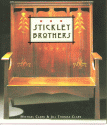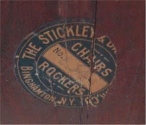From Brothers to Partners to Rivals: A Stickley Legacy

Five brothers, ranging in age from twelve to twenty-five, work together in a small furniture business in New York where they specialize in both making and selling ornate, elaborate Victorian chairs and rockers.
The name of their business: The Stickley Brothers Chair Company.
But, it seems, they cannot get along.
Not only do the five brothers eventually start four different furniture companies, they all decide to make Arts & Crafts furniture and, to varying degrees, compete for the same customers.
The eldest, Gustav Stickley, is the first to leave, taking younger brother Leopold with him to serve as his factory foreman. His business goes through a few different names, finally settling on the Craftsman Workshops.
In 1902 Leopold breaks away, with his older brother’s blessing, to start his own business with the youngest Stickley, John George. Using their initials, they eventually name their company the L. & J. G. Stickley Company.
John George Stickley quickly gains a reputation as being a fine salesman. Over the course of his brief career (he dies at age fifty), John George may have sold furniture for each of his brothers.
Charles Stickley, often dubbed “the forgotten brother,” stayed behind and with his uncle’s financing formed the Stickley & Brandt Chair Company. He oversees production of a wide variety of styles, ranging from ornate Victorian to a limited line of Arts & Crafts furniture.
Albert Stickley, the middle brother, takes the original family business name and moves to Grand Rapids, Michigan, the furniture capital of the world, in 1891. After a trip to London, some of his Arts & Crafts furniture adopts an English feel. He calls one line Stickley Brothers ‘Quaint’ Furniture, an English derived term for the Arts & Crafts style. Albert also manufactured Arts & Crafts furniture similar to that of his brothers.
Experience and examination has shown that each of the five Stickley brothers developed a distinctive and unique interpretation of the Arts & Crafts style. From a design perspective, they each had their good days and their not-so good days, they each had their successes and their failures.
And we get the opportunity to decide which we like the best.
– Bruce Johnson
Note: The most comprehensive study of the contributions of each of the five Stickley brothers resulted in the book Stickley Brothers: The Quest For An American Voice, published by Gibbs-Smith and written by Michael Clark and Jill Thomas-Clark. It is essential for anyone who collects Arts & Crafts furniture.

